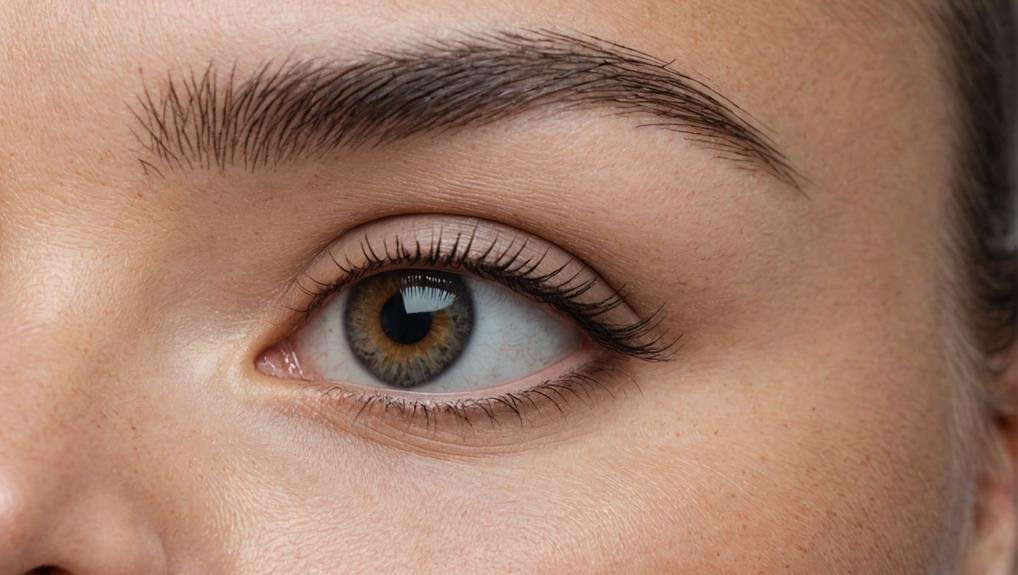You’re considering microblading and might be curious about the dramatic before-and-after results you’ve seen. This procedure can transform sparse brows into well-defined arches, enhancing your overall look. But what’s the real story behind those striking transformations? While the initial results might seem intense, understanding the healing process and how diligent aftercare impacts the outcome is vital. How does the pigment evolve, and what should you expect during healing? These insights are important before you commit to this popular cosmetic treatment. Let’s explore what you need to know.
Key Takeaways
- Through precise, hair-like strokes, microblading transforms sparse brows into full, defined arches.
- The healing process initially darkens brows, revealing true color and shape over weeks.
- Results can last 1-3 years with proper aftercare and yearly touch-ups.
- Customized microblading complements individual facial features for a natural look.
- Adherence to aftercare instructions ensures optimal healing and long-lasting effects.
Understanding Microblading
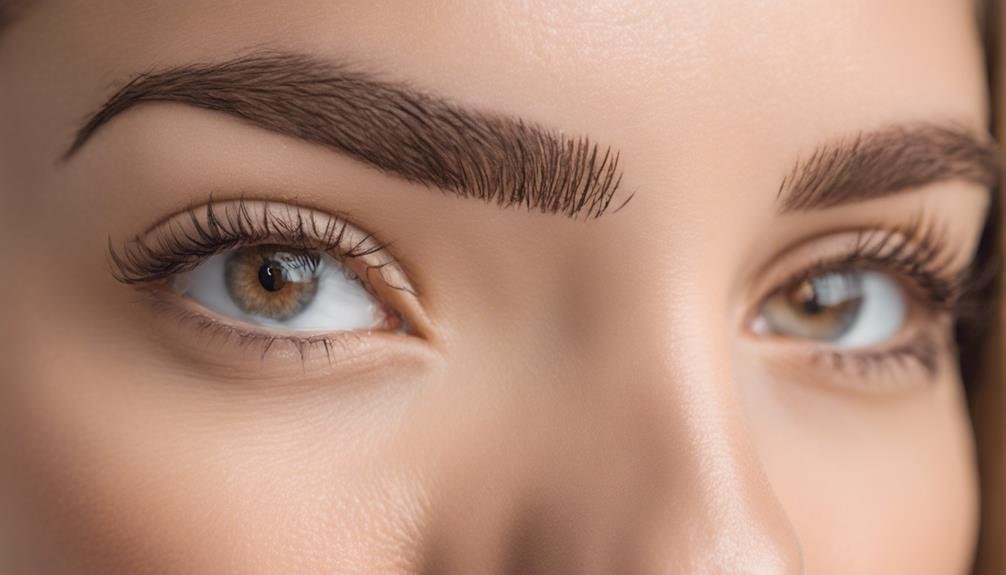
Microblading is a semi-permanent eyebrow enhancement technique that has revolutionized the beauty industry with precise, hair-like strokes. If you’ve ever wished for fuller, more defined brows, microblading might be the solution you’ve been searching for. This procedure involves using a hand tool equipped with tiny needles to deposit pigment into your skin, creating the appearance of natural eyebrow hairs. It’s particularly beneficial for those with sparse or uneven brows, offering a way to achieve a more polished and symmetrical look.
When you decide to undergo microblading, understanding the healing process becomes vital. Initially, your brows will appear darker and more pronounced than expected. Don’t worry; this is entirely normal. The pigment will gradually soften over the next few weeks and settle into a natural hue.
Following aftercare instructions diligently is crucial, as your skin will be sensitive during this time. Avoid picking at scabs or exposing your brows to excessive moisture. Keeping the area clean and applying any recommended ointments will facilitate optimal healing. Soon, you’ll enjoy beautifully enhanced brows that look effortlessly natural, thanks to skilled artists like Tiffany from Enhance Artistry.
Eyebrow Transformation
Watch your eyebrows transform as microblading breathes new life into sparse, shapeless brows. Imagine the excitement when, for the first time, you see the results that skilled brow artists like Tiffany from Enhance Artistry can achieve. Microblading turns your eyebrows into full, defined arches with natural-looking hair strokes that enhance your face’s overall appearance. It’s a remarkable change that brings dimension and color, making your eyebrows look naturally fuller and more structured.
By opting for microblading, you’re choosing a path toward well-defined brows that require minimal daily upkeep. No more fussing over pencils and powders every morning. Instead, you wake up with perfectly shaped brows, ready to face the day. This popular technique is perfect for those who want a polished and put-together look without the daily hassle.
For first-timers, the experience can be life-changing. A professional brow artist tailors each stroke to complement your natural shape, creating an individualized and sophisticated look. Whether filling in gaps or redefining your brow line, microblading offers an elegant solution for achieving the stunning eyebrows you’ve always desired.
Reasons for Removal
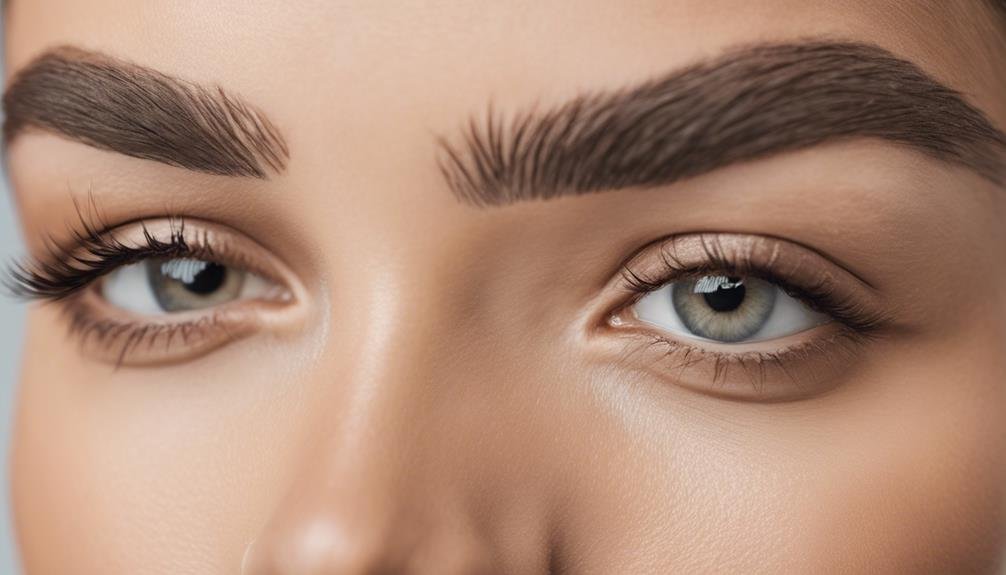
If you’ve experienced fading pigment issues or unnatural brow shapes after microblading, you might consider removal to regain your natural look. Sometimes, the results can make you self-conscious, prompting you to act.
Although the removal process can be lengthy and challenging, it’s a step toward feeling confident again.
Fading Pigment Issues
In cosmetic enhancements, fading pigment in microbladed eyebrows often leads to dissatisfaction, pushing many to contemplate removal. When the pigment fades, your eyebrows may lose their color intensity, resulting in a much lighter appearance than desired. This can be particularly frustrating if you aim for a full, defined look. Instead of enhancing your features, the fading strokes can leave your brows patchy and uneven, making it difficult for them to look natural.
Disappearing strokes are a common issue with microblading. Over time, those meticulously crafted hair-like strokes can fade, leaving noticeable gaps in your eyebrows. This fading pigment diminishes the aesthetic appeal and undermines the investment you’ve made in achieving your ideal brow look. You might feel self-conscious about the appearance of your brows, and the thought of removal might start to seem appealing.
However, it’s important to understand that removing microbladed pigment isn’t simple. The process can be challenging, especially when dealing with poorly executed or unwanted results. While removal can help rectify the situation, it’s essential to approach it with caution and seek professional advice.
Unnatural Brow Shapes
Unnatural brow shapes from microblading are among the top reasons people consider removal. When the procedure doesn’t go as planned, your brows can look too dramatic or oddly shaped. This can happen if the technician misjudges your natural brow line or uses a stencil that doesn’t suit your face. As a result, your brows might look mismatched or entirely out of place.
You might find that the strokes, initially meant to mimic natural hairs, start disappearing, or the pigment fades unevenly. These issues can make your brows look patchy, and instead of enhancing your appearance, they do the opposite. This dissatisfaction often leads individuals to seek removal options to restore their natural brow appearance.
Imagine waking up each day, looking in the mirror, and not recognizing the person staring back. It’s unsettling. You might’ve opted for microblading to save time or enhance your looks, but now you’re spending more time trying to hide or fix these unnatural brow shapes.
If you’re unhappy with how your brows turned out, prioritizing their natural restoration becomes essential. Removal can offer a fresh start, allowing you to regain confidence in your appearance.
Self-Consciousness Concerns
When microblading doesn’t meet expectations, the mirror’s reflection can often become a source of self-doubt. You might find yourself staring at eyebrows that feel more like a distraction than an enhancement. Self-consciousness concerns arise when the results appear unnatural, making you question your decision. These concerns aren’t uncommon, especially if the pigment fades unevenly or strokes disappear altogether, leaving you with brows that look anything but natural.
Unnatural appearances can also result from shapes that weren’t properly altered during the microblading process. If the arch is too high or the tails are misaligned, your eyebrows may draw more attention than intended. For many, these issues are enough to contemplate removal as a way to reclaim their confidence and restore their natural brow appearance.
Seeking removal can be a challenging journey. The process isn’t always straightforward, and it requires patience and persistence. However, it’s a step some choose to take to alleviate their self-consciousness concerns. By opting for removal, you can gradually move closer to the look you desire, reducing the anxiety of facing an unnatural appearance each day.
Post-Microblading Challenges
After microblading, you might notice the pigment fading faster than expected, leaving eyebrows patchy and uneven. This fading can make filling your brows with makeup tricky, as the strokes no longer align with your natural hair.
Additionally, a mismatch between natural hair growth and the microbladed strokes can create an awkward appearance, leading to frustration and possible self-consciousness.
Fading Pigment Issues
Fading pigment is a common post-microblading challenge that can leave your eyebrows looking less defined and natural. As the pigment starts to fade, you might notice disappearing strokes, which can transform your brows into a patchy canvas. This change affects the overall eyebrow appearance and can make the original microblading work seem inconsistent. The once crisp, well-defined lines can blur, leading to an unnatural look that mightn’t align with your expectations.
As the fading pigment progresses, you could experience a mismatch between your natural hair growth and the remaining microbladed strokes. This inconsistency can further emphasize the patchiness and contribute to an uneven look. It’s understandable if this makes you self-conscious about your eyebrows, and you might consider touch-up procedures or removal options to restore balance and harmony to your brows.
These challenges can be frustrating, especially if you’re unprepared for them. To maintain your desired brow appearance, it’s important to monitor the fading process and decide on the next steps, like scheduling touch-ups. Taking proactive measures can help you manage the changes and keep your brows looking their best.
Makeup Application Difficulties
Exploring the world of makeup application post-microblading can be an exercise in frustration. You might find that the once-crisp strokes now appear faded, and the pigment isn’t as vibrant as it used to be. This fading pigment can make it difficult to achieve a cohesive look as the contrast between your natural brow hair and the microbladed strokes becomes more pronounced. When applying makeup, you might struggle to blend these differences smoothly, leading to an uneven or unnatural appearance that can make you self-conscious.
Additionally, disappearing strokes can complicate your routine. As these strokes fade, they may require additional makeup to fill in the gaps, which can be time-consuming. You might even consider removal, but that process can be lengthy and challenging. This emphasizes the significance of thorough research and consultations before undergoing microblading, as understanding the potential for fading pigment and disappearing strokes helps set realistic expectations.
Proper aftercare is vital in maintaining your microblade brows, yet sometimes, even with the best efforts, makeup application challenges arise. It’s crucial to adapt your routine and find products that help balance these changes for a more seamless look.
Natural Growth Mismatch
A common challenge post-microblading is the mismatch between natural eyebrow growth and microbladed strokes. This mismatch can often create an unnatural appearance, especially if the microbladed pigment starts to fade. Your natural brow might grow in a different direction or density than the first round of carefully placed microblading strokes, leading to a less cohesive look over time.
When this happens, filling in your brows with makeup becomes more challenging. You might find it difficult to achieve a seamless blend between the natural hairs and the microbladed areas. This can lead to frustration and even self-consciousness as you try to maintain a look that initially seemed effortless.
To address this, consider scheduling touch-ups or corrective procedures. A professional touch-up can realign the microblade strokes to better match your natural brow growth, providing a more harmonious appearance.
If you’re experiencing significant mismatches, don’t hesitate to consult your technician about alternative solutions. They can guide you through the best approach to guaranteeing your eyebrows look as natural as possible while maintaining the desired balance. Remember, achieving the perfect brow often takes more than just the first round of microblading.
Realities of the Procedure
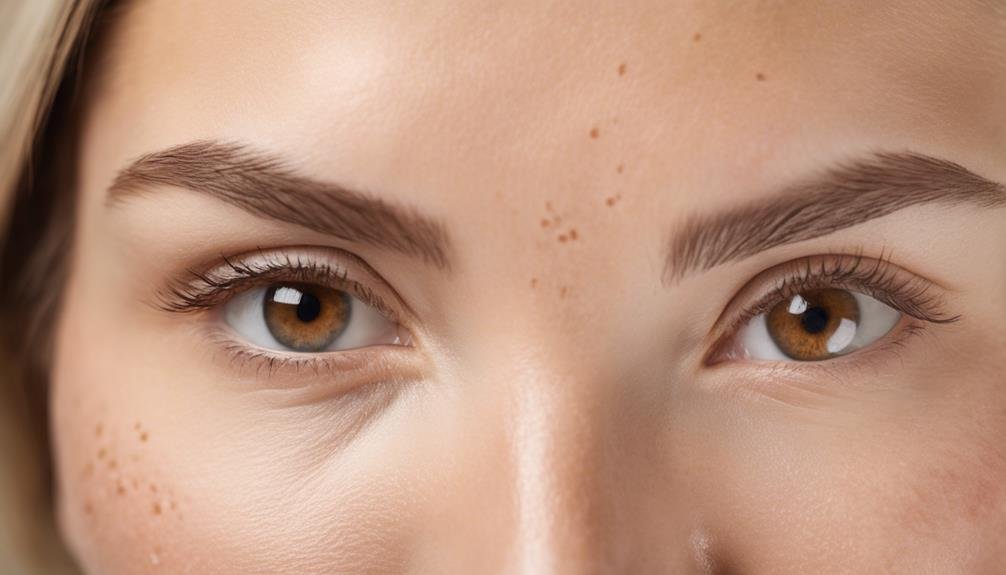
You might be intrigued by the allure of perfectly sculpted brows that microblading promises, but it’s important to understand the procedure’s realities. During your first session, a trained technician uses a semi-permanent technique that scratches pigment into your skin to create hair-like strokes. While the initial results can be impressive, they’re not immediate. It takes time for the skin to heal fully, and the final appearance may vary from person to person.
The reality is that microblading requires commitment. You should expect to need touch-up sessions to maintain your desired look because, over time, the pigment fades. Proper research and consultations are essential before you undergo microblading. This guarantees you have realistic expectations and achieve the outcome you desire. Not every technician is suited for every client, so choose wisely.
Education on the microblading process is vital. This includes understanding aftercare requirements and potential challenges, such as the possibility of needing removal if results aren’t satisfactory. Results can be unpredictable, and individual skin responses vary. Knowing these realities helps you make an informed decision. While microblading can enhance your features, it requires careful consideration and planning.
Healing and Aftercare
Understanding the realities of microblading leads naturally to the significance of the healing and aftercare process.
Right after your microblading session, you might notice your eyebrows darkening, feeling tight, and experiencing minimal pain for the first three days. This is all part of the typical healing process.
Expect some itching and slight flakiness as you approach days four and five. Resist the urge to scratch your brows, even when the itching intensifies.
You’ll likely see increased flakiness and patchiness between days six and ten as scabs form and naturally fall off. Letting the scabs shed on their own ensures proper healing and the best results.
Follow the aftercare instructions provided by your technician. These instructions might include keeping your eyebrows dry, avoiding makeup on the treated area, and applying recommended ointments.
Before and After Results
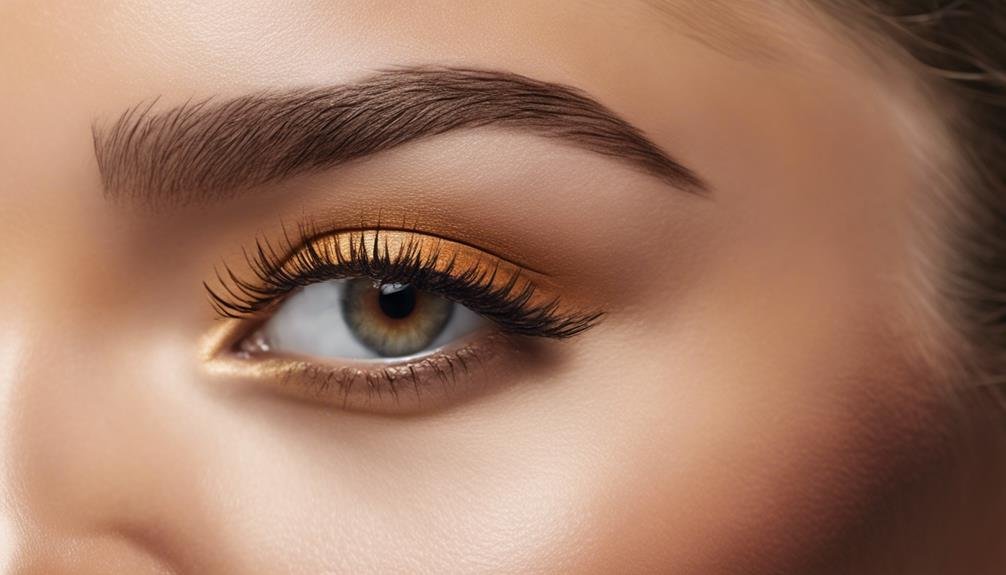
Eyebrow transformation achieved through microblading is truly remarkable. When examining the before and after images, the enhancement in eyebrow shape and fullness is undeniable. It’s captivating how this procedure can redefine your facial features and even save you time on daily makeup routines. The outcomes, however, don’t occur instantly. You’ll initially observe changes, but the real enchantment happens once your eyebrows have healed completely.
The healing process plays a vital role in the final result. It can take 4-6 weeks for your eyebrows to fully heal, during which time the pigments settle and reveal their true color and shape. Individual skin characteristics significantly impact the results, so adhering to aftercare instructions is crucial.
After your eyebrows have healed, the effects of microblading can last between 1 and 3 years. This duration depends on your skin type and how well you maintain them afterward. The transformation is customized to complement your face, making it a valuable investment for those looking for a long-term solution to sparse or uneven brows.
With proper care, the before and after outcomes can be transformative for your overall appearance.
Enhancements and Maintenance
Maintaining the stunning results of your microbladed eyebrows involves a few key practices. First, understand that yearly touch-ups are necessary to keep your brows fresh and vibrant. This helps maintain the shape and color you desire, ensuring your brows heal beautifully and continue to enhance your facial features.
Think of the cost of microblading as a monthly investment in consistently polished brows. Annual touch-ups are an essential part of maintaining your cosmetic tattoo.
Regular aftercare plays a significant role in pigment retention and the proper healing of your micro-bladed eyebrows. Post-procedure, applying a barrier cream is crucial. It protects your skin, aids in the healing process, and ensures the long-lasting effect of your cosmetic tattoo.
Without diligent aftercare, you risk poor results and accelerated fading, which can be disappointing after your initial investment.
Conclusion
You’ve seen how microblading can transform your eyebrows from sparse to stunning, giving you a natural and sophisticated look. While the initial boldness might surprise you, patience during the healing process pays off with beautifully defined brows. By following the aftercare instructions, you secure lasting results and a worthwhile investment in your appearance. Embrace the changes and maintenance it requires, and enjoy the confidence that comes with perfectly shaped brows every day.
FAQs
What should I expect before getting my eyebrows microbladed?
Before getting your eyebrows microbladed, it’s important to prepare properly and know what to expect during the process:
- Consultation: You’ll meet with a professional to discuss your desired brow shape, color, and thickness. They will map out your brows to match your facial structure.
- Avoid Caffeine and Alcohol: It’s best to avoid caffeine and alcohol for at least 24 hours before the appointment, as they can increase sensitivity and cause more bleeding.
- Numbing Cream: A numbing cream is applied to the brow area to minimize discomfort during the procedure.
- Patch Test: A patch test may be done to ensure that you do not have an allergic reaction to the pigments used in microblading.
Before Microblading Preparation:
- Consultation to plan the brow shape.
- Avoid caffeine and alcohol for 24 hours.
- Numbing cream application to reduce pain.
- Patch test for allergic reactions.
What are the typical results after microblading eyebrows?
After the microblading procedure, the results will look bold and defined but gradually soften over the healing period. Here’s what to expect:
- Initial Appearance: Immediately after the treatment, the eyebrows will look darker and more defined. This is normal and will fade by 30-50% as they heal.
- Healing Phase: Over the next 7-14 days, the brows may scab and peel slightly, and the color may appear lighter. Avoid picking at the scabs to prevent pigment loss.
- Final Results: After about 4-6 weeks, the true color and shape of your microbladed brows will be visible, appearing natural and well-defined.
- Touch-Up Session: A touch-up appointment is usually scheduled 4-8 weeks after the initial procedure to fill in areas where the pigment did not take properly.
After Microblading Results:
- Dark, defined brows initially.
- Healing with possible scabbing in 7-14 days.
- The true color appears after 4-6 weeks.
- A touch-up session for perfect results.
How do I care for my eyebrows after microblading?
Proper aftercare is essential for the best microblading results. Here are some tips to follow:
- Avoid Water: Keep your eyebrows dry for the first 7-10 days to prevent infection and ensure proper healing.
- No Makeup on Brows: To reduce the risk of irritation or infection, avoid applying makeup directly to your eyebrows until they have fully healed.
- Moisturize: Apply the recommended ointment or healing cream as instructed by your technician to keep the brows hydrated.
- Avoid Sun Exposure: Protect your brows from direct sunlight and tanning beds, as UV rays can cause the pigment to fade more quickly.
- No Touching or Picking: Do not pick at scabs or flakes, which can lead to pigment loss and uneven results.
Aftercare Tips:
- Keep brows dry for 7-10 days.
- Avoid makeup on the brow area.
- Moisturize with the recommended cream.
- Protect from sunlight to prevent fading.
- Do not touch or pick at the scabs.
What is the difference between microblading before and after?
The before and after transformation of microblading is significant and involves the following changes:
- Fullness and Definition: Before microblading, your brows may appear sparse or uneven. After microblading, they look fuller, more defined, and well-shaped.
- Natural-Looking Strokes: The hair-like strokes created during microblading give the brows a natural appearance and blend seamlessly with your real brow hairs.
- Color Enhancement: The pigment used in microblading enhances the color of your brows, making them stand out without looking overly dramatic.
- Low Maintenance: After microblading, you no longer need to fill your brows with makeup, saving time on your daily beauty routine.
Before and After Differences:
- Fuller, more defined brows after microblading.
- Natural hair-like strokes for realistic results.
- Enhanced color and shape of the brows.
- Reduced need for daily brow makeup.
